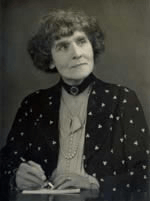Alice Verne-Bredt
| Alice Verne-Bredt | |
|---|---|
 Alice Verne-Bredt around 1920. | |
| Born |
1864 Southampton |
| Died |
1958 London |
| Nationality | English |
| Occupation | Pianist |
| Known for | Innovator of percussion bands for children in Great Britain. |
Alice Barbara Verne-Bredt (née Wurm; 1864, Southampton — 1958, London) was an English piano teacher, violinist and composer. She was also an innovator of percussion bands for children in the United Kingdom.[1]
Life and career
The sixth of ten children,[1] Alice was born in Southampton to Bavarian professional musicians who emigrated to England in the 1850s.[2] Her father was a music teacher specialised in zither, violin, and piano who worked as an organist,[3] and her mother a violinist who taught her the violin from a very early age,.[4] Later in her childhood she moved to London, where she lived all her life,[4] and there was taught piano by Robert and Clara Schumann's daughter, Marie.[4]
Alice wanted to become a singer someday, but due to typhoid fever she had her voiced ruined for good.[1] In 1893, her family anglicized their surname from Wurm to Verne,[2] and Alice married William Brendt, an amateur musician and conductor. Both greatly contributed with success for the piano school set up in London by her sister Mathilde Verne (1865–1936) in 1909.[1]
Alice took over the school’s junior department, where Lady Elizabeth Bowes-Lyon, later Queen Elizabeth the Queen Mother, had a wedding march written especially for her.[2] She died in London in 1958.[2]
Selected works
Chamber music
- Cello Sonata
- Phantasie Piano Trio (1908) – Cobbett prize winner. A composition for piano, violin and cello performed at the Aeolian and Bechstein Halls on 25 January 1912.[5]
- Phantasie Piano Quartet (1908) (unpublished)
- Phantasie Piano Quintet (no date, unpublished)
- Piano Trio, No. 2
- Piano Trio, No. 3
- Wiegenlied (lullaby) for violin and piano (1911)[6]
Piano music
- Arrangement of Pavane: from King Henry VIII's Pavyn (1924)[7]
- Four easy inventions for young pianists (1920)[8]
- Musical box
- The little drum
- Concert study
- The doll's promenade
- Polacca (Polka) for piano and orchestra (also for string accompaniment)[9]
- Valse (1913)[10]
- Valse Miniature for two pianos (1913)[11]
See also
References
- 1 2 3 4 "Alice Verne-Bredt". Keyboardgiants.com. Keyboard Giants. Retrieved 16 December 2014.
- 1 2 3 4 "Alice Verne-Brendt". Meridian-records.co.uk. Meridian Records. Retrieved 16 December 2014.
- ↑ Fuller, Sophie. "Women Composers during the British Musical Renaissance, 1880-1918" (PDF). Kclpure.kcl.ac.uk. King's College University of London. Retrieved 16 December 2014.
- 1 2 3 Seldon, Laura. "The instrumental music of British Women Composers in the Early Twentieth Century" (PDF). Core.kmi.open.ac.uk. City University London. Retrieved 16 December 2014.
- ↑ Seddon, Laura (2013). British Women Composers and Instrumental Chamber Music in the Early Twentieth Century. Ashgate Publishing, Ltd. p. nn. ISBN 1472402154.
- ↑ "Alice Verne-Bredt (composer)". Discography of American Historical Recordings. DAHR. Retrieved 16 December 2014.
- ↑ Catalog of Copyright Entries, Part 3, Issues 5-6. Library of Congress. Copyright Office. 1925. p. 528. OCLC 6481719
- ↑ "4 Easy Inventions for young pianists". Worldcat. OCLC. Retrieved 16 December 2014.
- ↑ "East End Wonder-Child". Paperspast.natlib.govt.nz. National Library of New Zealand. Retrieved 16 December 2014.
- ↑ "Valse". Worldcat. OCLC. Retrieved 16 December 2014.
- ↑ "Valse miniature, for two pianos". Worldcat. OCLC. Retrieved 16 December 2014.